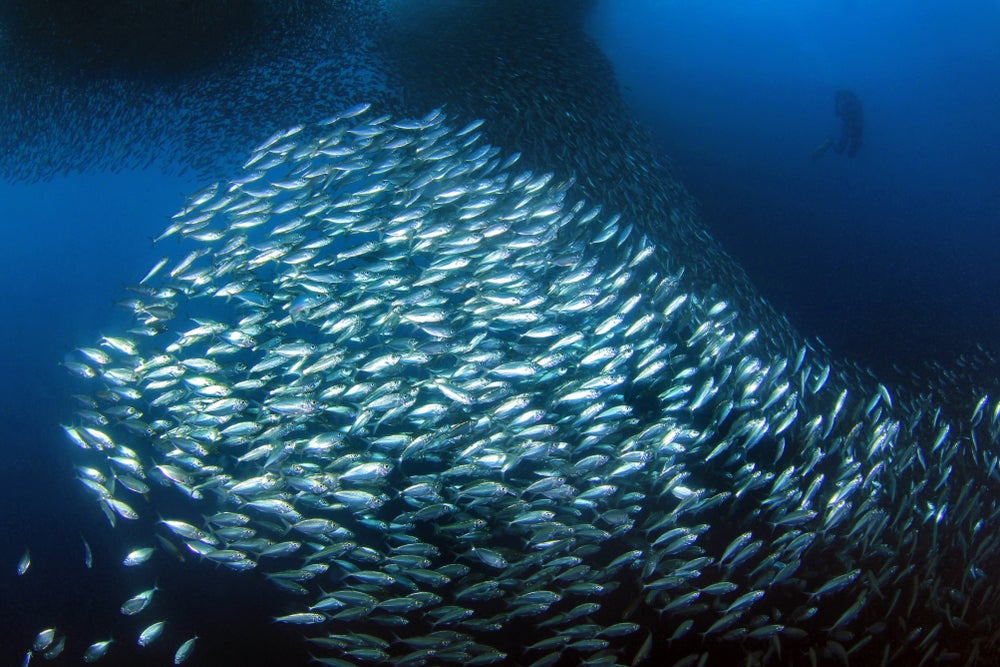July 19, 2021
The Plan to Save Sardines in the Philippines
Topics: Protect Sardines
The Filipino’s appetite and need for sardines make the humble fish species an important commodity in the market. Sardines account for 15 percent of Philippine marine fisheries, with an average annual production of 333,743 metric tons. Throughout the years, however, this commercial demand has also resulted in rampant overfishing, which in turn caused the decline in local sardine fish populations.
To conserve and develop our sardine fisheries, the Philippine government created its first ever National Sardine Management Plan (NSMP). The five-year plan outlines the goals, benchmarks and indicators, and proposals to achieve sustainability in the sardine fishing industry over the next five years.
Read along to know more about the plan:

A sardine run in Moalboal, Cebu. Photo by Daniel Lamborn.
1) It is a science-based management plan.
Developing policies on wildlife is futile when not prescribed by science; for this reason, the NSMP was created based on scientific studies and in consultation with the academe. In fact, it was originally conceived by the National Fisheries and Aquatic Resources Management Council, the country’s highest advisory body on fisheries policies.
The NSMP contains an introduction to the bio-physical aspects and life cycle of sardines. It also follows an ecosystem approach to fisheries management, which recognizes the different aspects and interactions in marine ecosystems in framing management strategies. In doing so, the plan could achieve conservation, sustainable use, and fair sharing of benefits in our sardine resources. These scientific principles would help fulfill the plan’s two main goals: to establish reference points for the top three sardine species, and to reduce juvenile catch by 10% by 2025.
2) It will strengthen the implementation of existing policies.
A handful of policies have already laid the foundation to efficiently manage sardine fisheries, and the new plan is designed to support these existing efforts. For example, the NSMP will aid the Amended Fisheries Code achieve its goal of food security by establishing reference points, harvest control rules, and a catch documentation and traceability system. It will support Fisheries Administrative Order (FAO) No. 263, which established Fisheries Management Areas (FMAs) in the Philippines. Under FAO 263, the plan will be integrated into the Ecosystems Approach to Fisheries Management (EAFM) Plan of each FMA and cover both municipal and commercial waters.
Other policies that will be strengthened by the NSMP include the Conservation and Protection Act of 2001 (RA 9147), Agriculture and Fisheries Modernization Act (AFMA) (RA 8435), and the Local Government Code (LGC) (RA 7160). The NSMP will also complement the provisions of fisheries administrative orders and circulars, such as the enactment of closed seasons in sardine-rich areas.

In the morning, fishermen unload vats of freshly caught sardines at Tagbilaran Port, Bohol. Photo by Lano Lan.
3) It aims to uplift the lives of those working in our sardine fisheries.
Despite being part of a significant fisheries industry, many sardine fishers remain poor. During the closed fishing season, those who work in commercial fishing companies such as cannery workers are left without jobs. Taking these into consideration, the plan intends to mitigate poverty among the sardine fisherfolk and stakeholders and improve their income capacity. Among the recommendations include the creation of alternative livelihood programs and conducting studies on the impacts of the closed fishing season.
A product of a participatory process among the government, civil society organizations including Oceana, scientists, fishers, and fisheries managers, the NSMP was launched last May 2020. Since its release, Oceana has been working with various fisheries stakeholders to effectively promote and implement the plan. In partnership with the Bureau of Fisheries and Aquatic Resources (BFAR), a series of NSMP orientation and workshops were conducted in Fisheries Management Areas (FMA) 7, 8, and 12 geared towards the adoption of the Plan in the FMAs. Inputs from various FMA stakeholders – Management Body, Scientific Advisory Group, Fisheries Bureau, fisherfolks, civil society organizations among others, are vital in the implementation of the Plan..
The next few years are critical for the success of the NSMP. Oceana commits to work with its different partners to realize the plan’s vision and objectives. With transparency, closer coordination, and inclusive participation, we could save the Philippines’ sardines and restore its abundance in our ocean.
Download the National Sardines Management Plan here.
